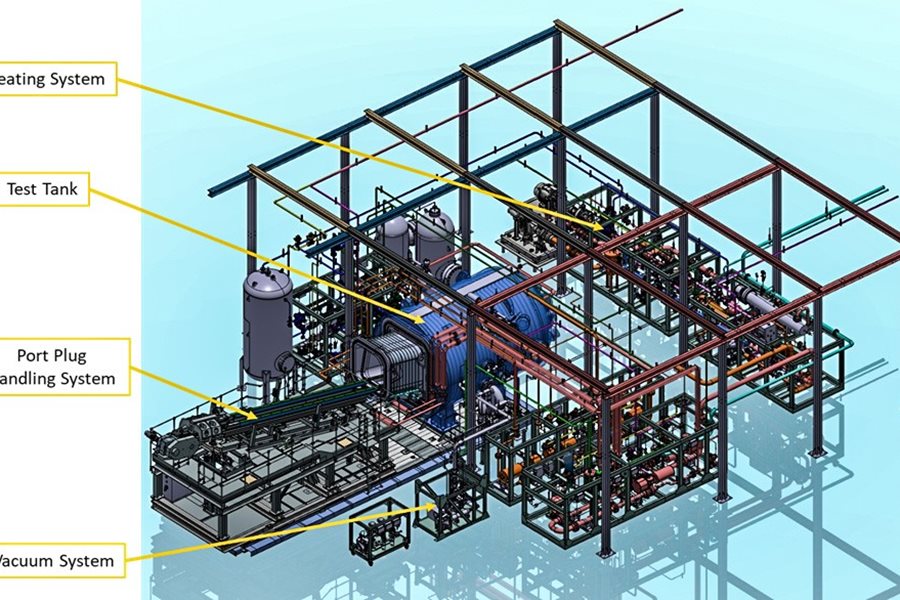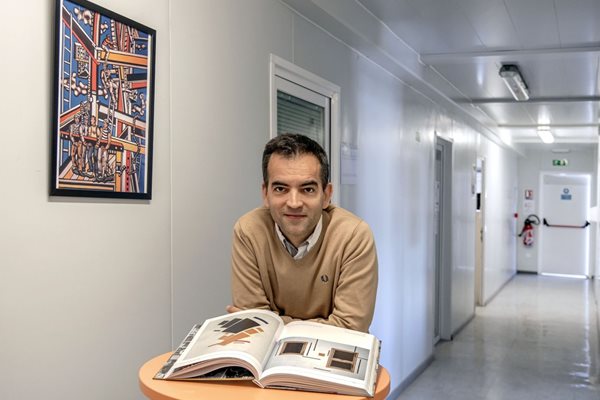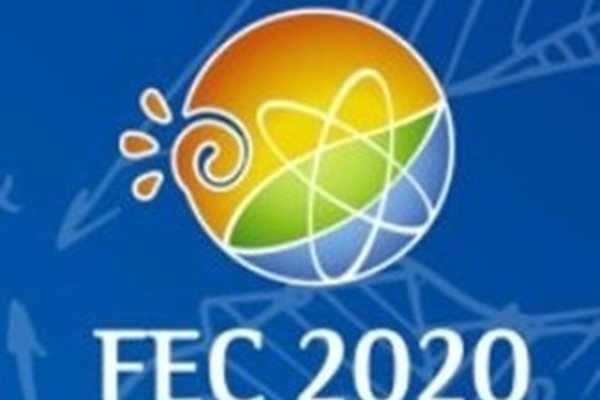
you're currently reading the news digest published from 26 Apr 2021 to 03 May 2021
featured2
of-interest2
press17
featured
Machine | Ensuring port plugs will work as planned
The stainless steel plugs sealing off each Tokamak port opening are not only massive, they are also complex—carrying and protecting some of the precious payloads of the machine, including diagnostics and heating system elements that are critical to efficient operation. To ensure that each port plug performs as required, a stringent battery of environmental and functional tests is planned before installation. Fourteen port plugs at the equatorial level and 16 at the upper level will host diagnostics, elements of the ion and electron cyclotron heating systems, and test blanket modules. These 30 plugs—designed to be removed for maintenance—are subject to stringent availability targets. To meet these objectives, ITER engineers plan to test the port plugs before installation on the machine and after any refurbishment during the operational phase. Test stands have been designed to perform both environmental tests (for example, appraising leak tightness under thermal cycling and high pressure) and functional tests. Three stands will be installed on site at ITER to test the port plugs after they are delivered and before installation on the machine; a third will be delivered directly to the European Domestic Agency for the testing of the plugs under its responsibility. Once operation begins, two of the stands will be installed in the nuclear environment of the ITER Hot Cell to test the plugs after refurbishment or maintenance during operation. The Russian Domestic Agency is procuring the four test stands for delivery between 2022 and 2024 through sub-contractor GKMP. Each test stand is composed of a test tank, a heating system, a vacuum system, and handling and control systems. Tests to ensure unique requirements can be met Some of the biggest technical challenges port plug manufacturers have to overcome are related to the unique environment in the ITER machine: the components have to withstand relatively rapid thermal cycling without breaking the vacuum seal that they represent in the port opening. 'Port plug material expands greatly,' explains Yury Rumyantsev, technical responsible officer at the Russian Domestic Agency. 'When stainless steel is heated from room temperature up to 240 °C it expands about 3 mm/per metre, which opens up the possibility of leakage in the port opening. To meet this challenge, manufacturers have had to select a specific metallic sealing gasket and fabricate the flange for this gasket with very high precision.' 'Very few applications have this combination of thermal cycling, high vacuum and nuclear requirements,' says Olesia Solovyeva, director of the ITER Project at GKMP. 'Our job is to provide the testing facilities that can be used to make sure the port plugs stand up to the challenges they will find in the ITER reactor.' One set of tests will submit the port plugs to thermal cycling at high vacuum. Engineers will perform three rounds (cycling from room temperature to 240 °C) and check for helium leaks coming from the port plug assemblies. Tests will also be performed to verify that the cooling circuits can handle both high pressure and pressure drops. Outgassing rates will be measured to make sure the vacuum is protected as temperature and pressure are applied. To run the tests, the port plugs will be installed in a test tank—a 40 m³ vacuum chamber that will emulate the vacuum conditions of the ITER Tokamak. The heating system used to cycle the temperature consists of a loop circulating water inside the port plug and around the test tank at 40 atmospheres of pressure to heat and cool the plug across the test range temperatures. Functional tests will depend on the nature of the diagnostics housed in the port plug—and by way of example, may include tests for electrical continuity, detector calibration tests, tests for the alignment and cleaning of diagnostic mirrors, or tests of shutter actuation. 'There is one specific case that has to be carefully handled by the port plug test facilities,' emphasizes Thierry Cerisier, ITER technical responsible officer for the project. 'If an assembly under testing fails in such a way that it causes a water pipe to break, this could cause the pressure inside the tank to soar to the point of damaging the port plug. To mitigate this, special overflow chambers have been included in the design of the test stands to relieve the pressure that might otherwise destroy some of the key elements on the port plug boundary.' An important milestone halfway through the project 'This year is the most important in the project lifecycle, because it's the year we start manufacturing,' says Solovyeva. 'The first test stand will be delivered to the ITER site in June 2022, and a second will be delivered to the European Domestic Agency soon afterwards. While the non-nuclear test stands are being manufactured, we will complete the design of the two nuclear test stands destined for the Hot Cell. These will be delivered to the ITER site in 2024.' 'The nuclear-ready stands will also be used during the earliest testing phase, before the port plugs are installed for the first time on the machine,' says Rumyantsev. 'Then when this phase ends, those stands will be modified slightly and transferred to their permanent home in the Hot Cell, where they will be used to test port plugs after they are repaired or upgraded.' The three ITER port plug test facilities will be installed in the European Poloidal Field Coils Winding Facility on site, where the "clean" conditions are ideal for the tests, and space has been made available courtesy of the European Domestic Agency. The first non-nuclear test stand will arrive on site in 2022 and will be installed just as coil fabrication is ending.
Construction | Art around every corner
Most of us have experienced it. Turning a corner in one of the Tokamak Building galleries and looking up at the graphic pattern of embedded plates in the concrete walls, or noticing the geometrical arrangement of steel rebar, we have been moved by a sense of beauty and balance—the kind of emotion one feels in front of a work of art. Oriol Ribas i Escolà is the ITER Project Director at Ferrovial, one the three companies (with Vinci and Razel-Bec) that form the VFR consortium responsible for the construction of the Tokamak Complex and eight other structures on the platform. In the course of his career he has worked on many large civil works projects in the United Kingdom and his native Spain, however what he has experienced at ITER can only be described as an aesthetic 'revelation.' Progressively, as he monitored the progress of construction, he began to see Malevich paintings, Dan Flavin installations and Donald Judd compositions almost everywhere. 'When I was a kid in post-Franco Spain, a period we call 'the Transition,' I studied in a school that was especially sensitive to artistic expression,' he says. 'And although I chose to become a civil engineer, something of that early education has stayed with me. After all, drawing is central to civil engineering and you need a sort of flair for geometry, volumes and the occupation of space.' At ITER, Oriol could in some cases instantly draw parallels between the shapes, colours and volumes that caught his eye and an artist or artistic movement. 'But at times, it was just something I felt, like a reminiscence that I could not put my finger on.' The encounter in September 2019 with José Manuel Ballester, a renowned Spanish painter and photographer whom Ferrovial commissioned to document its work on the ITER Project for a book commemorating the 70th anniversary of the company's inception, was decisive. 'As someone with a wide artistic culture, he could put names on my perceptions. We shared our awe of the pure artistic beauty of the ITER Tokamak and its environment. It was as if art, and art history, were present at every step.' Oriol began photographing scenes in and around the Tokamak Building. Workers in a steel structure reminded him of Fernand Léger's Les Constructeurs (1950). Dark openings framed in yellow-painted steel were the very shapes and colours of Malevich's Suprematist Composition: Airplane Flying (1915). Reinforcement around the openings of the bioshield was a perfect reproduction of Andy Goldsworthy's Screen (1998). A concrete structure in the neutral beam cell conjured the works of Eduardo Chillida, the mirror-like cladding of the building those of Anish Kapoor, and a neon light on a wall seemed to have been placed there by Dan Flavin ... In the Tokamak Complex and other constructions, Oriol tracked the legacy of the Concrete and Neo-Concrete movements, of Cubism, Constructivism, Minimalism, Futurism ... as if the ITER worksite had become the largest and most massive modern and contemporary art museum in the world. When VFR decided to publish a generously illustrated, 300-page coffee table book to celebrate the seven million work hours the consortium has invested in the construction of the ITER Tokamak Complex and auxiliary buildings, Oriol seized the opportunity to explore in an essay what he terms 'the fascinating connection between abstract art and construction.' Beyond this exploration however, Oriol pursues a broader objective. 'The world of modern and contemporary art is very difficult to penetrate. Most people see it as something quite elitist and snobbish, and do not understand why some of the works they see as absurd and meaningless are celebrated and sold for a fortune. My intention in my humble essay is to make apparent to them the connection between construction and art and contribute, however slightly, to offering a new perception. Also, as the book was originally intended for those who contributed to construction, I wanted them to feel pride for what they achieved.' Oriol views ITER as a 'unique masterpiece of artistic construction' and invites us to transgress 'the usual perception of concrete and steel structures to unveil their unlikely artistic soul.' As civil works in the Tokamak Complex near completion, the raw art of construction is fast vanishing from view. Soon, our eyes will be caught by other forms, shapes and compositions, but the beauty will endure, whether in the alien shape of a massive component, the complexity of an intricate piece of equipment, or the radiance of a burning plasma.
of-interest
Reminder: One week to FEC 2020
The 28th IAEA Fusion Energy Conference (FEC 2020) kicks off in just one week on 10 May 2021. For anyone who would like to join as an observer, you must register through this link by 7 May 2021. (Please note: observers can watch all presentations, but will not have access to the Q&A feature of the virtual platform or be able to interact.) The biennial Fusion Energy Conference is the premier gathering for the international fusion science community. It fosters the exchange of scientific and technical results in nuclear fusion research and development and provides a forum for the discussion of key physics and technology issues as well as innovative concepts of direct relevance to the use of nuclear fusion as a future source of energy. The 28th IAEA Fusion Energy Conference will be held as a virtual web congress from 10 to 15 May 2021. Organized by the International Atomic Energy Agency (IAEA), it is supported by the Government of France through the French Alternative Energies and Atomic Energy Commission (CEA) and the ITER Organization. To learn more about the six-day event, please visit the conference website: https://fec2020.fr/
58th Culham Plasma Physics Summer School
The 58h Culham Plasma Physics Summer School, planned in person from 6 to 17 September 2021, is open for applications.The aim of the Summer School is to provide an introduction to the fundamental principles of plasma physics, together with a broad understanding of its fields of application. The organizers of the School assume no previous knowledge of the subject, but familiarity with electromagnetism and applied mathematics at first degree level would be helpful. Lecturers are drawn from the Culham Centre for Fusion Energy (CCFE), the Rutherford Appleton Laboratory (RAL), and leading European universities. All are renowned experts in their fields. The deadline for applications is 30 July. For more details please visit: https://culhamsummerschool.org.uk/



